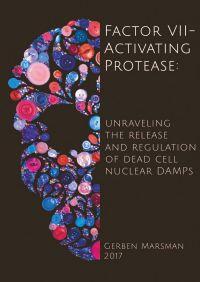Thesis Gerben Marsman
On 12 January 2017 (12:00 hrs) Gerben Marsman defended his thesis ‘Factor VII-activating protease: Unraveling the release and regulation of dead cell nuclear damps’ at the University of Amsterdam.
Promotores: Prof SS Zeerleder MD PhD and prof SM van Ham PhD
Copromotor: BM Luken PhD
Venue: Agnietenkapel, Oudezijds Voorburgwal 231, Amsterdam
The research described in this thesis was performed at the Department of Immunopathology of Sanquin Research (Amsterdam, The Netherlands). Financial support was provided by Sanquin, by the Landsteiner Foundation for Blood Transfusion Research (LSBR 0817), and by an unrestricted grant that Prof. dr. Sacha Zeerleder received from Viropharma. The printing of this thesis was financially supported by Sanquin Research and GaP Verlag.
Summary

Upon inflammation, uncleared dying cells are an important source of pro-inflammatory damage-associated molecular patterns (DAMPs). Major DAMPs are histones and double-stranded DNA, which together form chromatin. Factor VII-activating protease (FSAP) is activated upon contact with dead cells, and its proteolytic activity results in the release of chromatin from late apoptotic cells. In this thesis we studied the role of FSAP in the release of chromatin from dead cells and the regulation of extracellular DAMPs. We identified that FSAP not only liberates chromatin from late apoptotic cells, but in cooperation with DNase I also releases chromatin from necrotic cells. FSAP-mediated chromatin release from late apoptotic cells was impaired in serum from a subset of systemic lupus erythematosus patients. Dead cells induce the activation of FSAP, and we deduced that histones and RNA are likely the structures responsible for this activation. DNA-free histones are cytotoxic, but were efficiently degraded by activated FSAP. Histones within nucleosomes lacked cytotoxicity and did not induce FSAP activation. Notably, we detected nucleosomes and not DNA-free histones in sera of septic baboons and meningococcal disease patients. Not only histones, but the DAMP high mobility group box 1 protein (HMGB1) was also found to be degraded by active FSAP, although it did not induce activation of FSAP. We envisage an important role for FSAP in the release of chromatin from uncleared dying cells and in the degradation of histones and HMGB1. These functions suggest an important role for FSAP in the regulation of DAMP-mediated inflammation upon extensive cell death.
Chapters
Chapter 1
General introduction and scope of this thesis
Chapter 2
Histones, cell-free DNA, or nucleosomes: the immunity of extracellular chromatin unraveled.
Chapter 3
Cooperation of Factor VII-activating protease and serum Deoxyribonuclease I in release of nucleosomes from necrotic cells.
Arthritis Rheumatol 2014; 66(3):686-93.
Chapter 4
FSAP-mediated nucleosome release from late apoptotic cells is inhibited by autoantibodies present in SLE.
Eur J Immunol 2016; 46(3):762-71.
Chapter 5
DNA and Factor VII-activating protease protect against the cytotoxicity of histones.
Chapter 6
Factor VII-activating protease mediates the degradation of HMGB1.
Chapter 7
Cellular RNA and histones play synergistic but distinct roles in FSAP activation induced by dead cells in serum.
Chapter 8
Summarizing discussion
Download
Download PhD thesis (university repository)